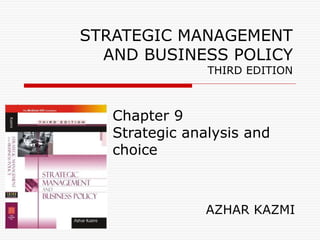
Chap9 Slides.ppt
- 1. STRATEGIC MANAGEMENT AND BUSINESS POLICY THIRD EDITION Chapter 9 Strategic analysis and choice AZHAR KAZMI
- 2. (c) Dr. Azhar Kazmi 2008 2 Learning objectives Describe the process of strategic choice Explore the tools and techniques for strategic analysis Examine the subjective factors in strategic choice Discuss the manner in which organisations handle unforeseen environmental events through formulation of contingency strategies Itemise the contents of a typical strategic plan for an organisation Discuss the strategic plan preparation and content for private and public sector organisations in India
- 3. (c) Dr. Azhar Kazmi 2008 3 Process of strategic choice Focussing on strategic alternatives Analysing the strategic alternatives Evaluating the strategic alternatives Choosing from among the strategic alternatives
- 4. (c) Dr. Azhar Kazmi 2008 4 Gap analysis for focussing on strategic alternatives Time T2 T1 Performance gap Desired performance Present performance Pe rf or m an ce
- 5. (c) Dr. Azhar Kazmi 2008 5 Dynamic competitive positioning Adapted from C.W.L. Hill & G.R. Jones: Strategic Management: An Integrated Approach Boston: Houghton Mifflin, 2007, p. 164
- 6. (c) Dr. Azhar Kazmi 2008 6 Strategic analysis Tools and techniques for strategic analysis Corporate portfolio analysis GE nine-cell matrix Corporate parenting analysis SWOT analysis Experience curve analysis Life cycle analysis Industry analysis Strategic groups analysis Competitor analysis
- 7. (c) Dr. Azhar Kazmi 2008 7 General Electric nine-cell matrix High Medium Low Strong Average Weak BUSINESS STRENGTH / COMPETITIVE POSITION INDUSTRY ATTRACTIVENESS GREEN YELLOW RED ZONE STRATEGIC SIGNAL INVEST / EXPAND SELECT / EARN HARVES T / DIVEST
- 8. (c) Dr. Azhar Kazmi 2008 8 Consolidated SWOT profile -------------------------------------------------------------------------------------------------------- ETOP Sector impact SAP Impact factor -------------------------------------------------------------------------------------------------------- Economic ↑ Market → Finance ↓ International ↓ Marketing → Political → Operations ↑ Regulatory → Personnel → Social ↑ Information management ↑ Supplier → General management ↑ Technology ↑ Up arrows indicate favourable impact; down arrows indicate unfavourable impact, while horizontal arrows indicate a neutral impact.
- 9. (c) Dr. Azhar Kazmi 2008 9 Porter’s five forces model of competition in an industry Potential threats from firms which make substitute products or services Forces of competition created by rivalry Buyers’ bargaining power Potential threat from entry of new firms Suppliers’ bargaining power
- 10. (c) Dr. Azhar Kazmi 2008 10 Components of competitor analysis Future goals of competitor Current strategy of competitor Key assumptions made by competitor Capabilities of competitor
- 11. (c) Dr. Azhar Kazmi 2008 11 Subjective factors in strategic choice Considerations for governmental policies Perception of critical success factors and distinctive competencies Commitment to past strategic actions Strategist's decision styles and attitude to risk Internal political considerations Timing and competitor considerations.
- 12. (c) Dr. Azhar Kazmi 2008 12 Contingency strategies Contingency strategies are formulated in advance to deal with uncertainties that are a natural part of the business The prospects of emergencies or disasters The phenomenon of serendipity A model of contingency planning consists of three steps: Identifying the contingent events Establishing the trigger points Developing and strategies and tactics
- 13. (c) Dr. Azhar Kazmi 2008 13 Strategic plan A strategic plan (also called corporate, group, or perspective plan), is a document which provides information regarding the different elements of strategic management and the manner in which an organisation and its strategists propose to put the strategies into action.
- 14. (c) Dr. Azhar Kazmi 2008 14 Contents of a comprehensive strategic plan A clear statement of strategic intent covering the vision, mission, business definition, goals and objectives. Results of environmental appraisal, major opportunities and threats, and critical success factors. Results of organisational appraisal, major strengths and weaknesses, and core competencies. Strategies chosen and the assumptions under which those strategies would be relevant. Contingent strategies to be used under different conditions. Strategic budget for the purpose of resource allocation for implementing strategies and the schedule for implementation. Proposed organisational structure and the major organisational systems for strategy implementation including the top functionaries and their role and responsibility Functional strategies and the mode of their implementation Measures to be used to evaluate performance and assess the success of strategy implementation.